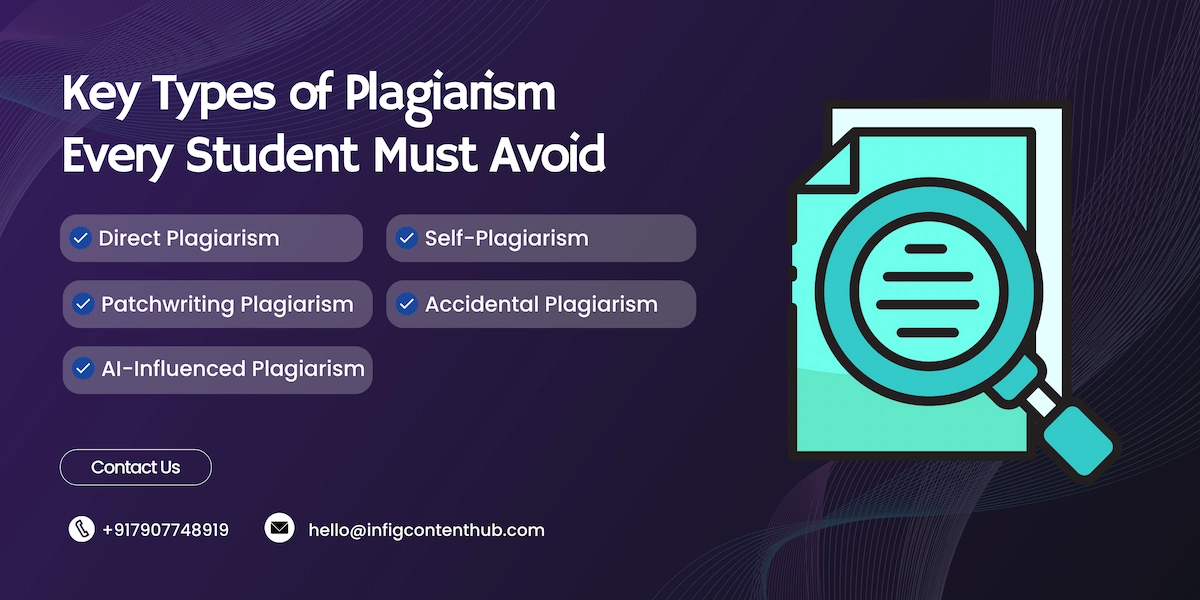What is Plagiarism? How Does It Affect Your Assignment Score?
Why is a plagiarism-free assignment important?
Academic integrity:
Avoiding plagiarism shows that you have utmost respect for the work of others and reflects your honesty and transparency in academia. It shows that you are a committed and dedicated student who creates your own ideas instead of taking shortcuts.
Legal penalties:
Plagiarism has serious consequences, which not only give you low grades and failed assignments but can even cause suspension or expulsion from universities and colleges. In some cases, not learning how to remove plagiarism in assignment can cause legal issues especially if the work or ideas you used are copyrighted.
Credibility Damage:
Your personal reputation can be seriously damaged in front of your faculty and peers. If you are caught plagiarizing someone else’s work, everyone can question your reliability and trust, which can affect your long-term career opportunities.
Different Types of Plagiarism That You Should Know

Direct plagiarism:
Copying word-for-word from a source that is written by someone else and presenting it as your own.
Patchwriting plagiarism:
Rephrasing someone else’s work but keeping the original idea or concept without proper acknowledgement and citations.
Self-Plagiarism:
Reusing your previous work and submitting it again without citation or reference to where you had used it earlier.
Accidental plagiarism:
This is the most common mistake when forgetting to cite a source, leading to misunderstandings and miscommunications.
AI-influenced plagiarism:
When you use AI-generated text, it can also mean that these are not your own ideas or works, and can cause ethical academic problems.
| Type | Example | Preventive Measure |
|---|---|---|
| Direct plagiarism | Copy pasting from a website | Cite source or use quotation or write in Italics |
| Patchwriting plagiarism | Rephrasing the words but keeping the original ideas | Paraphrase completely and cite the work |
| Self-Plagiarism | Submitting previous works written by you | Get permission |
| Accidental plagiarism | Forgetting to cite in bibliography | Keep track of all citations |
| AI-influenced plagiarism | Submitting content written by ChatGPT and other AI platforms | Cite the AI tool if used. Best to avoid it completely. |
How to do an assignment without plagiarism?
Step 1 – Check Assignment Guidelines
Before you start, always check with the assessment guide from your college or university. Understand the topic, scope, and expectations from the faculty. This helps you to stay focused and not use copied content without proper citations.
Step 2 - Research & Take Original Notes
Research well on the assignment topic and gather information from credible sources. Write the notes in your own words and avoid copying sentences. This demonstrates your own understanding of the subject.
Step 3 - Paraphrase Smartly
Paraphrasing does not mean changing the words with synonyms. Check similarity for assignment even in ideas or concepts. For example:
Accurate Paraphrasing: Using someone else’s work without credit causes plagiarism. To avoid it, always acknowledge the source and mention it in the citations.
Step 4 - Use Accurate Citations and Referencing
All educational platforms follow standard referencing styles such as MLA, APA, Chicago, or Harvard. Using these styles shows that you respect the original authors.
Step 5 - Use Plagiarism Checkers
When you check your assignment for plagiarism, the best way is to use a plagiarism detection tool such as Turnitin, Grammarly, Scribbr, or PlagScan. These tools ensure that your work is original and catches even the smallest plagiarism, and that you have used them.
Step 6 - Avoid AI Tools
In 2025, AI plagiarism detectors have become quite advanced at detecting AI text. Although AI simplifies our work, in the academic context, using your own words is always preferred. Even if you use AI, cite the tool, but for assignments, it is best to avoid it completely.
How to make an assignment without plagiarism?
Use synonyms and restructure your sentences:
One of the best ways to paraphrase the context is not just with synonyms, but by changing the structure. Make sure the sentence flow is fresh and sounds unique to your writing style.
Restructure the concept, don’t just swap words:
It is always best to explain concepts as per your understanding. Remember, the faculty looks for your personal touch in the assignments.
Use AI only for inspiration:
Using AI is OK as long as it is used to generate ideas or brainstorm. For example, you can ask AI for a list of case studies to use for your management assignment. The case studies can blend well with your topic, and mentioning them can reflect your deep academic knowledge, but copying them word for word will cause plagiarism.
Steps to Take If You’re Accused of Plagiarism
Remain calm and review your work:
Avoid panic and check your assignment for plagiarism. Identify where the plagiarism has occurred.
Use checkers to detect the issue:
Conduct an assignment check for plagiarism through the plagiarism detection tools. This will show you the exact problematic areas.
Revise using original insights:
Rewrite the affected areas in your own words by using your own analysis and understanding. Write completely from scratch.
Seek support from academic advisors:
You are always welcome to seek guidance from your academic advisor or faculty to ensure that the revised work meets the assessment criteria.
Conclusion
Originality is always more valuable than referenced content. It is essential that you take your time and research well with a properly cited academic paper before submission. This reflects your commitment to your program and your strong dedication to academics. Plagiarism has always been a serious issue in the academic domain, and hence it is of utmost importance that you avoid it completely. If you are unsure how to go about it, you can always take professional assignment help, such as DCWI. DCWI’s professional writing service ensures well-structured work that meets your university standards and keeps your academic reputation solid.






